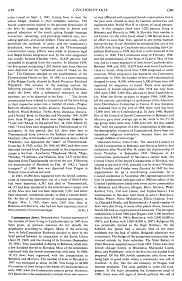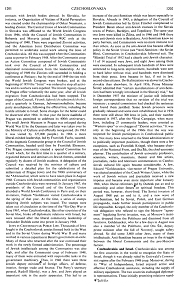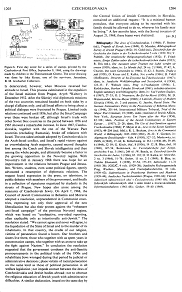<Contemporary Jewry.
DEMOGRAPHY.
[Jewish mass flight from
Sub-Carpathian Ruthenia from the Red Army to Moldavia]
Various estimates of the number of Jews living in
Czechoslovakia in 1945 have been given, as postwar
statistics do not classify the population according to
religion. Many of the surviving Jews in Sub-Carpathian
Ruthenia decided to leave in the brief period between its
annexation to the Soviet Union (June 29,1945) and the
closing of its frontiers (September 30, 1945). They
succeeded in fleeing to Bohemia, while only a few hundred
moved to Slovakia. Most of the newcomers registered with the
Jewish communities only later.
[Numbers of Jews in 1947 /
1948]
In 1948, 19,123 Jews were registered with the communities in
Bohemia and Moravia. The number of Jews in Slovakia in 1947
was estimated at about 24,500. This brings to 44,000 the
number of Jews living in the whole of Czechoslovakia in
early 1948, when the Communists came to power. However, this
figure has to be augmented to include those who were in
(col. 1199)
no way affiliated with organized Jewish communities, but in
the past were classed as Jews by German authorities and
registered after World War II as victims of racial
persecution [[half Jews, quarter Jews, 3/4 Jews etc.]].
In this category there were 5,292 persons living in Bohemia
and Moravia in 1948. In Slovakia their number is not known;
on the other hand, about 5,500 Slovak Jews, in an effort to
save their lives, agreed to pro forma baptism during the war. It can
therefore be estimated that out of the 356,830 Jews living
in Czechoslovakia (including Sub-Carpathian Ruthenia) in
1939, less than a sixth remained in the country in 1948.
[Communist coups and
emigration waves - the young generation is leaving]
The communist coup of February 1948, and the establishment
of the State of Israel in May of that year, led to a mass
migration of Jews from Czechoslovakia. Between 1948 and
1950, 18,879 Jews went from Czechoslovakia to Israel, while
more than 7,000 emigrated to other countries. When
emigration was barred by the communist authorities, in 1950,
the number of Jews still remaining had dropped to some
18,000, while some 5,500 of them were still registered for
migration to Israel.
There were sporadic instances of Jewish emigration after
1954 but only from 1965 were 2,000-3,000 Jews allowed to
leave Czechoslovakia. After the Soviet invasion in August
1968, 3,400 Jews left the country, according to a spokesman
of the American Joint Distribution Committee in Vienna. It
may therefore be assumed that at the end of 1968 there were
less than 12,000 Jews left in Czechoslovakia.
In June 1968, Rudolf Iltis of the Council of Jewish
Communities in Bohemia and Moravia gave their average age as
60, while in the 15-20 age group there were only 1,000 Jews
left. He also added that "with the exception of a few
communities in Slovakia, the demographic situation of
Czechoslovak Jewry does not necessitate religious
instruction, because there are not enough children of school
age".
[[Emigration went mostly to Palestine into the eternal war
trap of the racist Zionist Free Mason Herzl regime in
Jerusalem. The enthusiasm covered this fact that Herzl
Israel was a war trap]].
ORGANIZATIONAL STRUCTURE.
[dominating racist Zionism in CSSR Jewry]
The renewed Council of Jewish Communities in Bohemia and
Moravia held its first conference after World War II, under
the chairmanship of Ernst *Frischer, in September 1945.
Delegates of 43 communities participated. In Slovakia a
similar body, the Central Union of the Jewish Communities in
Slovakia, was created at the end of 1945, presided over by
Armin *Frieder. Both Frischer and Frieder were [[racist]]
Zionists.
In 1947 the two organizations set up a coordinating
committee. At a Council conference in November 1963
representatives from only 16 communities took part and in
1968 the editor of the Council's publications listed only
seven active communities in Bohemia and Moravia (Prague,
Brno [[Germ. Bruenn]], Ostrava, Plzeň [[Germ. Pilsen]],
Karlovy Vary [[Germ. Karlsbad]], Ústí nad Labem [[Germ.
Aussig]], and Teplice-Sanov [[Germ. Teplitz-Schönau]]). Ten
communities in Slovakia were listed as active (Bratislava,
Ko¨ice, Pre¨ov, Nitra, Michalovce, ´iliina, Galanta, Trnava,
Dunajská Streda, and Ru¸omberok). A small number of Jews
were also living in some other places where, however, Jewish
life had no organizational framework.
[Numbers of Jews in 1968:
old age homes, no Jewish children or youth]
The strongest communities in June 1968 were Prague, with
3,500 members (more than 4,000 in 1945), Bratislava, with
2,000 (8,000 in 1947), and Ko¨ice [[Germ. Kaschau]] with
1,800 (4,000 in 1947). Religious life was practically
limited to the High Holidays. On the Sabbath few places had
a minyan [[10 or
more Jews needed for a worship service]]. One of the main
problems was the lack of rabbis. Religious education was
nonexistent. The budget of the pauperized communities was
covered entirely by State subsidies. The State Bakery in
Zlaté Moravce [[Goldmorawitz]] supplied mazzot [[unleavened
bread]] from 1965. There were four Jewish old-age homes, in
Bratislava [[Germ. Pressburg]], Marianské Láznĕ [[Germ.
Marienbad]], Brno, and Podĕbrady [[Germ. Podiebrad]]; only
in the first two was kosher food prepared.
Of the 800 Jewish cemeteries only those were being kept in
good order where a community was still in existence. A few,
like the old cemetery of Prague, had become museums. The
same applied to some old synagogues.
[Political life 1945-1948 -
no political life since the communist coup of 1948 -
emigration stopped - celebrating anniversaries]
In the years preceding the communist coup of 1948, there
were still signs of Jewish political life and of (col. 1200)
contacts with Jewish bodies abroad. In Slovakia, for
instance, an Organization of Victims of Racial Persecution
was created under the chairmanship of Oskar Neumann, a
leading Zionist. The Central Union of Jewish Communities in
Slovakia was affiliated to the World Jewish Congress from
1946, while the Council of Jewish Communities in Bohemia and
Moravia joined the WJC only at the beginning of 1948. There
were organized Zionist activities, and the American Joint
Distribution Committee was permitted to undertake social
work among the Jews of Czechoslovakia. All this was stopped
when the communists came to power in February 1948. After
the communist coup an Action Committee composed of Jewish
communists took over the Council of Jewish Communities and
eliminated non communists from the leadership. At the
beginning of 1949 the Zionists still succeeded in holding a
conference at Prie¨tany; but by the end of 1949 the ties
with the World Jewish Congress were broken, and at the
beginning of 1950 the "Joint" was ordered to stop all
activities and its workers were expelled.
The Jewish Agency closed its Prague office voluntarily the
same year, after all Jewish migration from Czechoslovakia
had been stopped. The organ of the Council, Vĕstnik ¸idovských
nábo¸enských obcí, and a quarterly in German, Informtionsbulletin,
[["News Bulletin"]] became party mouthpieces, following the
official line, including the hostile attitude to Israel.
Some changes for the better could be discerned after 1964.
In that year the hevra
kaddisha [[Jewish burial society]] of Prague was
permitted to celebrate its 400th anniversary.
The small Jewish Museum in Prague was enlarged during World
War II by the Germans and later was taken over by the
Ministry of Culture and officially reorganized. (In 1963 it
was visited by 327,000 people). IN 1966 a more
liberal-minded leadership, led by Franti¨ek Fuchs, succeeded
the dogmatic communist group in the Council of Jewish
Communities, headed until then by Franti¨ek Ehrmann. The
Prague community created a special Committee for Youth
which, for the first time in a quarter of a century,
organized lectures and seminars on Jewish themes, attended
regularly by dozens of Jewish students. A delegation of the
Council was received by the minister of culture and
submitted a detailed plan for the celebrations of the
millennium of Prague Jewry and the 700th anniversary of the
*Altneuschul, which were to have taken place in August 1968.
[Jewry after Six-Day War
since 1967: stamps and broken ties]
Contacts with Jewish communities and organizations outside
Czechoslovakia were renewed. In January 1967, the presidents
of the Council and of the Central Union attended a World
Jewish Conference in Paris and, on their invitation, Nahum
*Goldmann visited Czechoslovakia in the spring of that year.
At the time, a series of stamps depicting Jewish subjects
was issued. The stamps were taken out of circulation at the
time of the *Six-Day War in June 1967, when Czechoslovakia,
like other countries of the Soviet bloc, broke diplomatic
relations with [[racist Zionist Free Mason Herzl]] Israel,
but were reissued after the liberal community leadership of
Alexander Dubček came into power in January 1968.
JEWS IN CZECHOSLOVAK PUBLIC
LIFE. [Jews in the government after 1948 - new
antisemitism in CSSR - Slánský trial - Jews excluded from
public life - revival in the 1960s - new antisemitism
after "Soviet" invasion since 1968]
[...] Many of those who returned after the war continued
their work in the newly formed administration. The
percentage of Jewish intellectuals among the communists was
also high, and after the communist coup of February 1948,
many of them were entrusted with responsible tasks in the
government machinery. Thus, in 148 there were three Jewish
deputy ministers of foreign affairs, of defense, interior,
foreign trade and finance. The Party's secretary general,
Rudolf Slánský, was a Jew, and Jews played an important role
in the party apparatus. This led to an (col. 1201)
increase of the antisemitism which was latent especially in
Slovakia. Already in 1945, a delegation of the Council of
Jewish Communities led by Ernst Frischer complained to
President Bene¨ about anti-Jewish excesses in the Slovak
towns of Pre¨ov, Bardĕjov, and Topolčany. The same year two
Jews were killed in ´ilina, and in 1946 and 1948 there were
anti-Jewish riots in Bratislava. Antisemitism knew no party
barriers, and communists were no more immune to it than
others. As soon as the anti-Jewish line became official
policy in the Soviet Union (see *Anti-Semitism: the Soviet
Bloc), Communists in Czechoslovakia followed suit.
The *Slánský Trial of 1952 had a clearly anti-Jewish
character: 11 of 14 accused were Jews, and eight Jews among
them were executed. In subsequent trials hundreds of Jews
were sentenced to long-term imprisonment, hundreds were sent
to hard labour without trial, and hundreds of Jews were
sentenced to long-term imprisonment, hundreds were sent to
hard labour without trial, and hundreds were dismissed from
their posts.
Jews became in fact, if not in law, second-class citizens.
De-Stalinization was slower in Czechoslovakia than
elsewhere. In April 1956, Prime Minister ¦iroký admitted
that "certain manifestations of antisemitism had been
wrongly introduced in the Slánský trial", but in December
1957 the minister of justice still informed foreign
correspondents that no revision of the trial was necessary;
a special commission had checked the sentences and found
them justified.
Some Jewish prisoners were gradually released and some even
rehabilitated, but in 1956 there were still about 300 Jews
in jails, and their number increased in 1957, after the
*Sinai Campaign, when many Jews, including 27 community
leaders, were arrested as "Western spies" or on charges of
"Zionist activities". It was only at the beginning of the
1960s that the way was reopened for Jewish participation in
Czechoslovak public life. Not many Jews returned to the
State administration or to politically important positions,
though there were a few exceptions, such as Franti¨ek
Kriegel, who became chairman of the National Front, and Ota
¦ik, the chief economic planner. The contribution of Jewish
university professors, scientists, writers, musicians,
theater and film artists, journalists, radio and television
commentators to Czechoslovak cultural life again became
considerable. A Jew Eduard *Goldstuecker, vice-rector of
Prague University, was elected president of the Czech
Writers Union, while the work of Jewish writers and
journalists received a new impetus and became even more
important after January 1968, when liberal reformers led by
Dubček put an end to censorship and other fetters
[[limitations]] on spiritual freedom. This period was,
however, short-lived.
The Soviet invasion of August 1968 put an end to it, and a
new wave of antisemitism, fed by Soviet, Polish, and East
German propaganda, made further Jewish participation in
public life impossible. Kriegel, the only member of the
Czechoslovak delegation who refused to sign the Moscow
"agreement" legalizing Soviet invasion, was, at Moscow's
insistence, dropped from the Politburo and dismissed from
all functions. Goldstuecker, who for a few days in August
was also a member of the Politburo, and Ota ¦ik, deputy
prime minister after the fall of Novotný, sought safety
abroad. So did some 3,400 other Jews, many of them
intellectuals. Antisemitism became an issue in the struggle
between the liberal communists and the pro-Moscow faction.
Czechoslovakia and Israel.
[criminal Zionist Free Mason Herzl Israeli regime is no
friend of CSSR government]
Czechoslovakia was among the first countries in the world to
recognize the State of Israel, though it was already ruled
by Gottwald's communist regime after the February 1948 coup.
Moreover, during its *War of Independence, Israel enjoyed
active and effective Czechoslovak assistance, including the
supply of military equipment. The two countries exchanged
diplomatic representatives. These initially promising
relations rapidly (col. 1202)
deteriorated, however, when Moscow reversed her attitude to
Israel. This process culminated in the expulsion of the
Israel minister from Prague, Aryeh *Kubovy in December 1952.
After the Slánský trial diplomatic missions of the two
countries remained headed on both sides by a chargé
d'affaires only, and all Israel efforts to bring about a
political dialogue were frustrated by Prague. Limited trade
relations continued until 1956, but after the Sinai Campaign
even these were broken off, although Israel's trade with
other Soviet bloc countries in the period between 1956 and
1967 showed a remarkable increase.
In June 1967, Czechoslovakia, together with the rest of the
Warsaw Pact countries (excluding Rumania [[Romania]]), broke
off relations with Israel. The one-sided attitude adopted by
Czechoslovakia in the Arab-Israel conflict, and Israel's
rapid victory against an overwhelming Arab majority, caused
second thoughts first among the Czech and Slovak
intelligentsia and then among the whole people, and
ultimately became a factor in the growing opposition to the
Novotný regime. With Novotný's fall in January 1968 there
was hope for an improvement in the relations between Prague
and Jerusalem. Writers, students, even some political
figures, openly advocated a resumption of diplomatic
relations. The request found expression in the press, on
television, in public debates with members of the
government, and finally in a collection of signatures
organized by students in the streets of Prague. New hopes
also arose among the remnants of Czechoslovak Jewry.
On April 7, 1968, the Council of Jewish Communities in
Bohemia and Moravia adopted a resolution, unprecedented in
communist countries, expressing not only their approval of
the new liberalization but also their protest against the
"vehement anti-Israel campaign" of the previous Novotný
regime, which was based on "unobjective, one-sided
reporting, often explicable only as intentionally
anti-Jewish". The resolution stated:
"We cannot agree and never will agree, to the liquidation of
the State of Israel and to the murder of its inhabitants. In
that country, the cradle of our religion victims of
persecution found a haven. Our brothers and sisters live
there, those who together with us spent years in
concentration camps, who together with us arose to take up
the fight against Nazism."
In conclusion the resolution requested that the government
condemn the anti-Semitic pronouncements in the political
trials of the 1950s and rehabilitate Jews wronged during
that period by judicial or administrative decisions; place
victims of racial persecution on the same level as those of
political persecution in all welfare legislation; not impede
contact between the Jews of Czechoslovakia and Jewish bodies
abroad; not to obstruct the religious education of Jewish
youth with adminstrative difficulties.
A similar declaration, issued on the same day by (col. 1203)
the Central Union of Jewish communities in Slovakia,
contained an additional request:
"It is a minimal human postulate, that everyone asking to be
reunited with his family should be allowed to do so,
wherever his family may be living."
A few months later, with the Soviet invasion of August 21,
1968, these hopes were shattered.
[AV.D.]
 previous
previous


